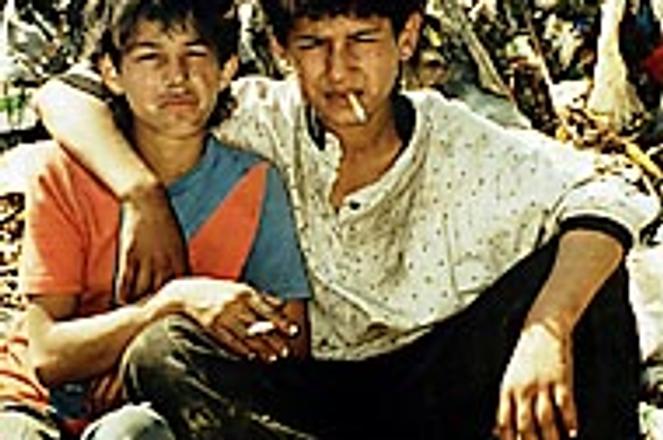Roma on a wastedump in the Paskievich film The Gypsies from Svinia, playing in Bratislava this week.photo: Courtesy NFB Canada
A few hundred metres from the "white" part of Svinia, an eastern Slovak village, there is a "black ghetto". Half of the village's 12,000 population, the "blacks" or Roma, live there on a drained swamp in crumbling concrete blocks and huts made of sticks and mud. They drink dirty water and go to the bathroom in bushes. Naked children eat from bowls on the floor; flies cling to the faces of sleeping babies. Teenage girls nurse infants while smoking cigarettes.
"What I could not show in my film is the smell," said Canadian director John Paskievich, 53, born in Austria. "The smell there is horrific."
Images of the impoverished "black" settlement alternate with those of well-kept "white" houses in Paskievich's 1999 film The Gypsies from Svinia. The 95-minute documentary will be one of 163 films shown during the nine-day International Film Festival Bratislava, starting November 30. It is one of two documentaries on the lives of Slovak Roma and one of two Paskievich films at the festival.
The film centres on Canadian anthropologist David Scheffel, who started a project in 1993 to help the Roma in Svinia become more self-sufficient by building their own houses. It argues that Slovakia's transition from communism to democracy has pushed Roma there to the margins of society. Mostly unemployed and living off welfare, they often steal from the homes and harvests of their white neighbours, causing a cycle of increasing tension in the community.
"If I had a gun I would shoot them all and then myself," says a woman in the movie, after screaming at a group of Roma to leave her shop.
Although finished in 1999, the film comes to Slovakia for the first time; Slovak television stations were not interested in showing it and festival organisers only learned of it this year. Its discovery has led to a mini Roma theme - The Gypsy House (2001), a 33-minute documentary by Marko Škop, a look at three Slovak Roma settlements, will also be shown at the festival.
This family of seven, like most families seen in the film, live in a one room hut.photo: Courtesy NFB Canada
"Paskievich's film is interesting because the project to solve Svinia's problem didn't come from the Slovak side," said Peter Nágel, festival programme director. "Many foreign institutions address Roma problems, but unfortunately it is not much discussed in the public."
Paskievich learned about Svinia's racial divide from Scheffel, an old friend. Scheffel came to the village in 1993, where he found "the worst living conditions I have ever seen". A Czech immigrant to Canada, he began writing to foundations across the world, searching for grants to start the housing project. Meanwhile, he told Paskievich about what he had seen.
"I was amazed when I visited," said Paskievich, who decided to shoot a film on the spot. "I never knew anything like that existed in central Europe. People should be aware of it."
Paskievich filmed Gypsies from Svinia during eight weeks between 1997 and 1999. The narrative twists between the successes and failures of Scheffel's project, including initial enthusiasm among the Roma followed by periods of doubt and disenchantment. The story is interlaced with Roma history, from their migration from India in the 13th century to Nazi persecution in World War II to a forced end to their nomadic lifestyle under communism.
Paskievich recalls the difficulties of filming the Roma, who viewed him as an outsider. Some were happy that he would show the world their living conditions, which might bring help. But others avoided his camera because they were ashamed at how they lived.
The festival will also show Paskievich's newest documentary, My Mother's Village, about Ukrainians forced into exile during and after World War II. Paskievich's own family were among the displaced. They were transported to forced labour camps in Austria in 1941 and emmigrated to Canada in 1952.
Both Paskievich, who started as photographer and whose work is exhibited across Canada, and Scheffel, who is still working on the Svinia housing project, will lead discussions at the festival screenings of The Gypsies from Svinia.
What: The Gypsies from Svinia
Where: Star Century Cinemas in Polus City Center, Vajnorská street
Tel: 02/5441-0673, 5441-5310,Polus: 02/4910-2222
The film is part of the International Film Festival Bratislava. A complete schedule of the festival's 163 movies is available at: www.iffbratislava.sk

